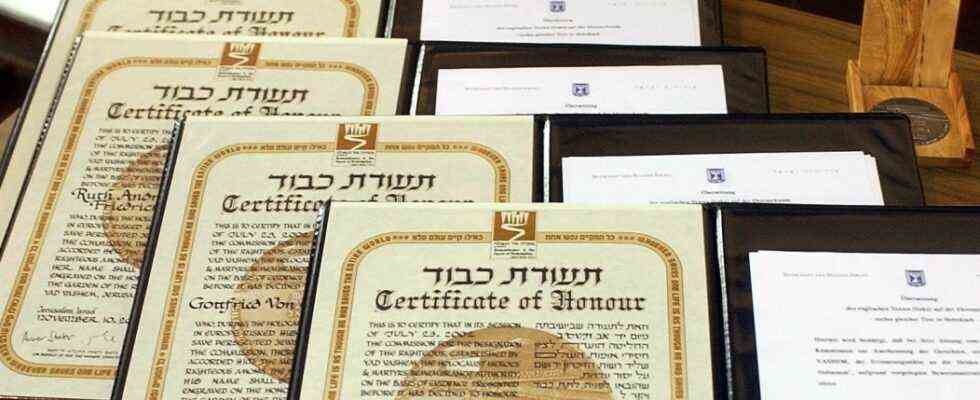The French historian and political scientist Jacques Semelin examines forms of aid for the Jewish victims of persecution and the Holocaust. In his study “Without weapons against Hitler” he describes the daily resistance to National Socialism, in which thousands, if not tens of thousands, participated.
An example of this is the French town of Chambon-sur-Lignon, where Jews were saved from being attacked by the National Socialists. In the village in the Haute-Loire department, the country of the Huguenots, where persecution was known firsthand, thousands of Jews were rescued between 1941 and 1944 by hiding them in private homes and farms, but also in public institutions, and issuing them forged papers and smuggled across the Swiss border.
When German patrols approached, the Jews were hidden in the countryside outside the town. Later residents went into the woods and sang a specific song to indicate to the Jews that the imminent danger was over. The rescue operation was unique in that an entire community of Christian charity came together to save Jews from death.
For Semelin it was a logical step to go via the “monstrosity of barbarism” to the humanitarian side of human behavior – that of resistance. What is meant is a resistance that men and women put up with their bare hands, a resistance that is expressed in small anonymous gestures of protest and symbolic actions and in the smallest possible deviation in a dictatorship – nonconformity.
Fritz Stern spoke of “active decency”
This includes collective forms of resistance such as rallies, strikes, refusal tactics, disobedience and other illegal actions that can be classified under the term moral courage. Arno Lustiger introduced the term “rescue resistance” for this type of resistance.
And the German-American historian Fritz Stern once excellently characterized the quiet, mostly secret form of resistance as “active decency”. This describes the behavior of those who wanted to maintain a humane orientation during the years of National Socialism.
To resist an armed power means to fight differently and to invent original forms of opposition. When the Vichy government began the deportations in the summer of 1942, Parisians protested against the introduction of the yellow star with demonstrations of solidarity by ridiculing this measure: They cut paper stars to which they wrote “Negro” or pinned the yellow one Star at your dog when you go for a walk with him.
The most notable solidarity movement in the history of the Holocaust was undoubtedly the rescue of the Jews in Denmark: 95 percent of the Jewish community was spared deportation by being brought to Sweden by ship. The reason: a country that was largely free of anti-Semitism and had a high level of social cohesion among its population. Jews were fully regarded as members of the nation.
“The immense power in nonviolent action”
The Danish government upheld a firm political principle vis-à-vis Berlin: to take sides with the Jews meant to defend a cornerstone of the Danish constitution, namely the legal equality of all citizens. In just a few days, saving the Jews had become a national matter across all social classes.
It was a lesson about “what tremendous power lies in nonviolent action and in resistance to an opponent who is often superior in terms of the means of violence”, says Hannah Arendt in her essay “Eichmann in Jerusalem”. The example of Denmark thus became proof that solidarity could still exist in National Socialist Europe, in the direct vicinity of treason, which had been elevated to a system. It proves that a small, unarmed people, foreign to anti-Semitism, had the ability to break the diabolical logic of the Holocaust.
Jacques Semelin: Without weapons against Hitler. A study on civil resistance in Europe. Translated from the French by Ralf Vandamme. Wallstein Verlag, Göttingen 2021. 281 pages, 34 euros. E-book: 26.99 euros.
The Holocaust came at the end of a development of anti-Semitic forces, the deep roots of which went back well before the war. They grew as the international environment remained indifferent to the persecution of the Jews. Even the Allies, although in the picture, did nothing essential to prevent the annihilation. Against the background of total war, Auschwitz did not represent a strategically relevant goal from their point of view. The civil rescue resistance was far more effective – than doing nothing. Of course, its efficiency cannot be judged solely in the light of Danish events.
They were mostly simple people
The selfless helpers, the “Righteous Among the Nations”, are heroes of their time and the most precious moral capital that European societies possess because they have preserved the honor of their fellow citizens and humanity during the most barbarous times. They were mostly simple people who never achieved the fame of Oskar Schindler or Raoul Wallenberg, who did not want to achieve it, but who had a moral compass capable of saving the entire universe.
The silent, “unsung” heroes were rarely given a memorial. This is what Jacques Semelin has now done with his study. This historical behavior is taking shape through the humanitarian dimension of the Jewish rescuers.
Ludger Heid is a historian. He lives in Duisburg.

